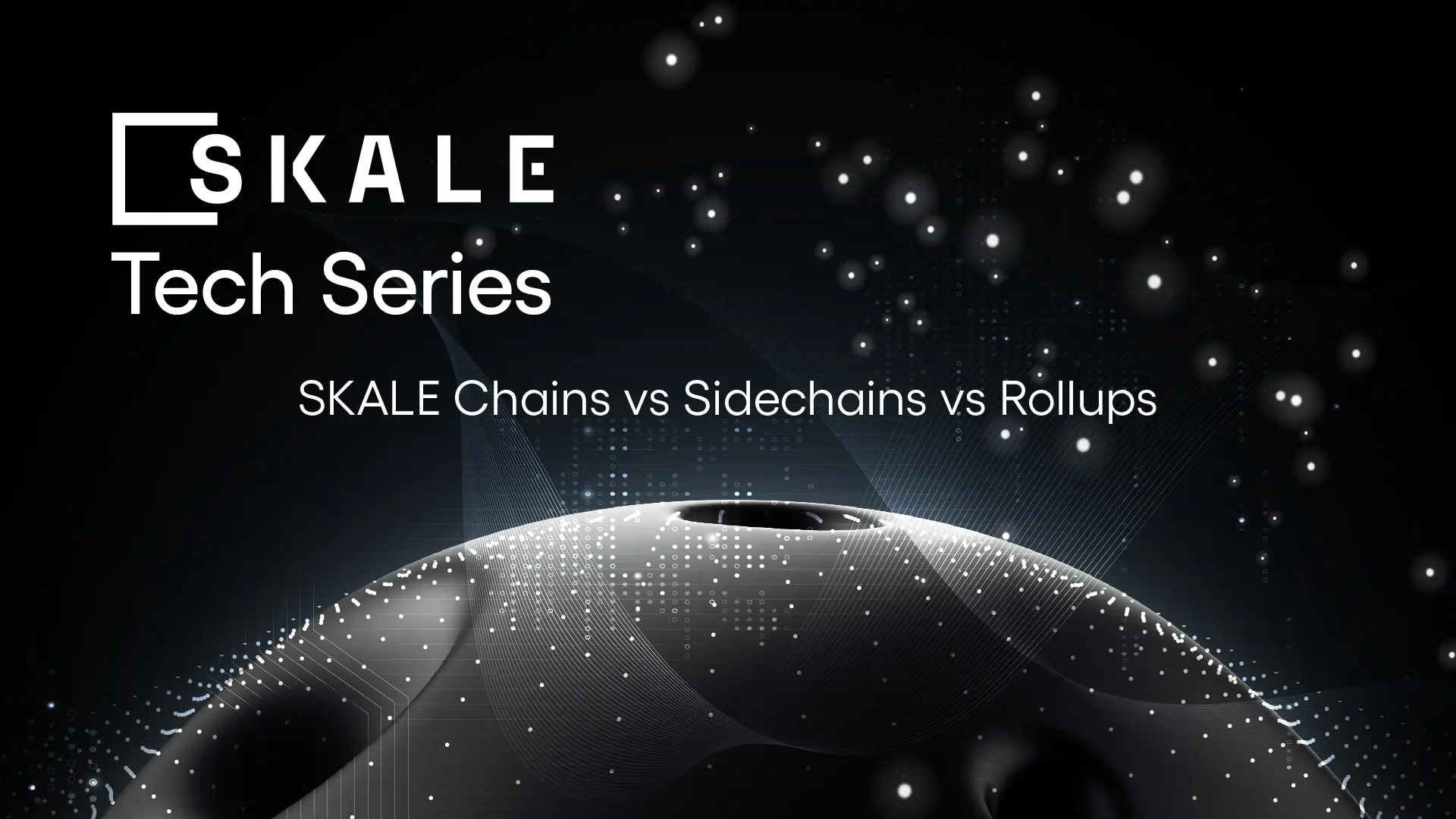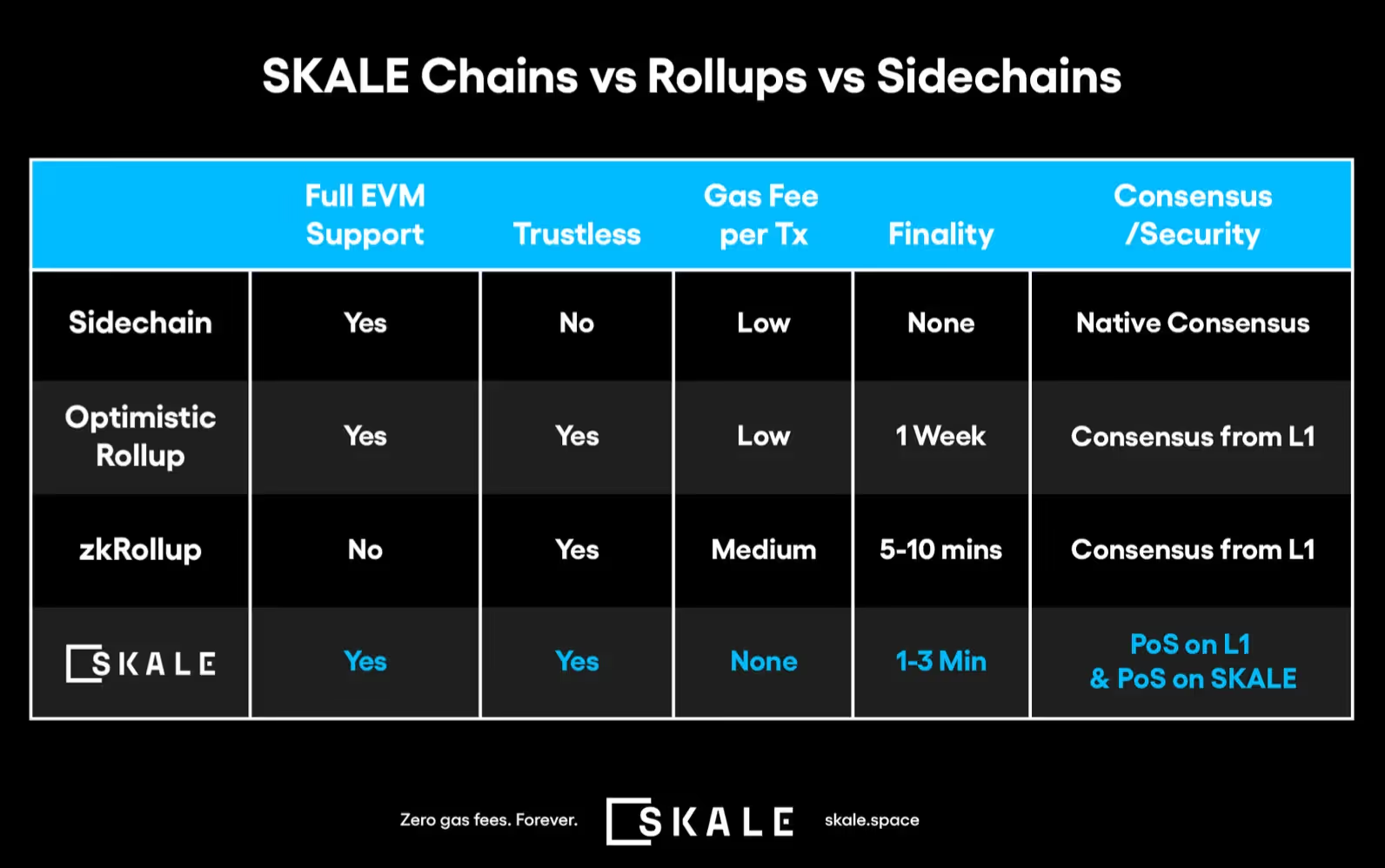SKALE Chains vs Sidechains vs Rollups | SKALE

The SKALE Network is an innovative, secure, and modular Ethereum scalability solution. While there are various blockchain scalability solutions, the SKALE Network is unique because it’s a network of Web3 Ethereum-compatible and interoperable blockchains.
What do we know about current Ethereum scaling solutions, and what advantages do SKALE chains have over solutions like sidechains and rollups? This article will compare Ethereum scaling solutions like sidechains and rollups to SKALE’s solution, known as SKALE Chains.
Why are Ethereum scaling solutions needed?
For Web3 mass adoption to succeed, Ethereum must scale to handle more users and transactions than ever before. The scalability of a blockchain refers to a blockchain’s ability to support a high-transaction throughput.
If Ethereum is more scalable, then it means that it can support more dApps, DAOs, NFTs, and other use cases. Essentially, it can handle more transactions and users. The goal is to increase Ethereum’s transaction speed and throughput without sacrificing decentralization or security. This issue affects all blockchains, commonly called the “blockchain trilemma.”
Many scaling solutions are referred to as “Layer 2” or “Execution Layer” solutions, meaning that they are a network or protocol built on top of another blockchain (a “Layer 1” blockchain). A Layer 1 blockchain refers to the base architecture of a blockchain. The Lightning Network, for example, is a Layer 2 scaling solution built for Bitcoin, a Layer 1.
The Layer 1 blockchain here is the Ethereum mainnet. An Ethereum Layer 2 solution would handle transactions outside the Ethereum mainnet to reduce network congestion while still enjoying the security benefits of the Ethereum mainnet.
Other Ethereum scaling solutions have emerged, including sidechains and rollups. Ultimately, these scaling solutions are meant to utilize Ethereum’s available resources as efficiently as possible.
While the Ethereum Merge drastically changed how Ethereum will consume energy, it doesn’t address issues like volatile gas fees or transaction speed. Still, we support the Merge and believe it improves support for scaling solutions like the SKALE Network.
What does the scaling landscape look like?
There are many different scaling solutions in the Ethereum landscape, including sidechains, rollups, and SKALE chains.
Sidechains
A sidechain is a separate blockchain that connects to another blockchain (the “main blockchain” or “mainnet”) via a two-way bridge. In Ethereum’s case, the sidechain would connect to the Ethereum mainnet. These secondary blockchains have their own consensus mechanisms and block parameters.
Since sidechains do not rely on Ethereum for consensus, they can choose alternative consensus protocols based on their needs. They operate through validator nodes verifying transactions and storing blockchain data.
The original concept of a sidechain centered around transferring assets rather than scalability. Because of SKALE Network’s interoperable Ethereum-native multichain network, it cannot be categorized as a “sidechain.”
Rollups
A rollup improves Ethereum scalability by executing transactions outside the main Ethereum blockchain.
One crucial fact to remember about rollups as an Ethereum scaling solution is that they aren’t blockchains. Instead, they’re an algorithmic approach to combining multiple blockchain transactions into a single Layer 1 transaction through smart contracts.
There are also different types of rollups, which we will discuss shortly.
SKALE Chains
As we mentioned, the SKALE Network is a network of interoperable Ethereum-native blockchains. These blockchains are called SKALE chains.
One main difference between SKALE chains and sidechains is that much of SKALE chains’ operational mechanics and security model are either staked into and/or controlled by smart contracts running on the Ethereum mainnet. While sidechains are usually responsible for their own security, SKALE chains can leverage the security of the Ethereum mainnet.
All SKALE chains use BLS threshold signatures to operate. A BLS threshold signature creates a cryptographic key from a shared private key using a distributed set of participants.
How does each technology work?
The next step is to dive into exactly how these technologies work.
Sidechains
Sidechains are independent blockchains connected to their parent blockchain (or mainnet) by a two-way bridge. Unlike Layer 2 solutions, which are built on top of a Layer 1 blockchain, sidechains operate parallel to their base blockchain.
Sidechains can serve several functions, including executing transactions, smart contracts, and storage. Sidechains that are EVM-compatible can be a useful scaling solution for Ethereum-native dApps.
These sidechains are also innovative because they can act as bridges between blockchains, which can help strengthen entire blockchain ecosystems. They can also act as experimental “sandboxes,” where developers can test features and additional use cases. Unfortunately, they often cannot leverage the security of the base layer (Layer 1) blockchain.
While they improve blockchain interoperability, sidechains often sacrifice both decentralization and/or security to achieve scalability.
Rollups
Next, let’s discuss rollups. There are two main types of rollups: optimistic rollups and zero-knowledge rollups.
Optimistic Rollups
Optimistic rollups reduce computation on the Ethereum blockchain by processing bundles of transactions off-chain and submitting them to Ethereum. These rollups are called “optimistic” because they assume these off-chain transactions are valid.
Instead, there is a “contest period” for up to a week where transactions can be contested before being finalized. Also, withdrawals are often not allowed until after the contest period is over.
Zero-Knowledge Rollups
Zero-knowledge rollups, or ZK-rollups, also round up bundles of transactions to be executed off-chain. However, they differ in one crucial way: unlike optimistic rollups, they do not assume that the transaction batches are legitimate.
Instead, ZK-rollups use a kind of cryptography called a Zero-Knowledge proof, or “validity proof,” to determine whether a transaction is valid. This saves a significant amount of both time and computing power, which makes ZK-rollups faster and more efficient than optimistic rollups.
The SKALE Network
The SKALE Network operates using a pooled validation model, where nodes are randomly selected and frequently rotated across multiple SKALE chains. However, the SKALE Network’s security is directly tied to Ethereum since most of the SKALE Network’s operating contracts run on the Ethereum mainnet.
How does the SKALE Network differ from both sidechains and rollups? Let’s examine some of the many advantages that SKALE chains offer.

The advantages of SKALE chains
The SKALE Network is a modular blockchain network that is the best possible option for Ethereum scalability. What are some of the unique advantages that the SKALE Network has to offer?
First and foremost, SKALE chains are not just one blockchain. The SKALE Network is a multichain network. Unlike traditional Layer 2 solutions, the SKALE Network is built to support an ever-expanding network of interconnected blockchains.
Second, SKALE chains allow dApps to store their files in-chain. This means that websites, applications, and NFTs can be stored within the SKALE chain, reducing the need for centralized database solutions.
Third, SKALE chains do not require any end-user gas fees, meaning that gas fee volatility within the SKALE Network is not an issue. Volatile gas fees have unfortunately been a serious issue for the Ethereum network. They remain an obstacle in terms of Ethereum scalability and Web3 accessibility, and mass adoption in general.
The SKALE Network uses a Proof-of-Stake consensus model and operates based on a pool validation model. Each validator stakes value in the network in the form of SKL tokens (the native cryptocurrency and utility token of SKALE). These stakes, maintained within the Ethereum mainnet, handle a significant percentage of SKALE Network’s operations.
Every SKALE chain offers instant finality, meaning that transactions are instantly recorded on the blockchain. The SKALE chain thus has an obvious advantage over other scaling solutions like optimistic rollups.
The SKALE Network utilizes virtual subnodes and compressed block proposals for additional scalability. In fact, the SKALE Network can support an unlimited number of blockchains.
Conclusion
The SKALE Network is the best choice for a world-class Web3 experience, thanks to its adaptability, instant finality, and security. While rollups and sidechains have their own advantages, the SKALE Network is the most logical solution for those hoping for true Ethereum scalability while enjoying the security benefits of the Ethereum mainnet.
Ethereum has been responsible for some of the most important trends in blockchain, including the rise of DeFi and NFTs. The recent Ethereum Merge might mean that Ethereum is more environmentally-friendly, but it doesn’t fully address its scalability issue. SKALE Chains are unprecedented blockchains in the Web3 world: they are decentralized, secure, and scalable.
SKALE chains have found a way to address the blockchain trilemma, as they remain decentralized, secure, and scalable simultaneously. The beauty of the SKALE Network is that it is also customizable, resilient, and scalable, empowering both Web3 scalability and innovation.
.webp)
.webp)
.webp)





